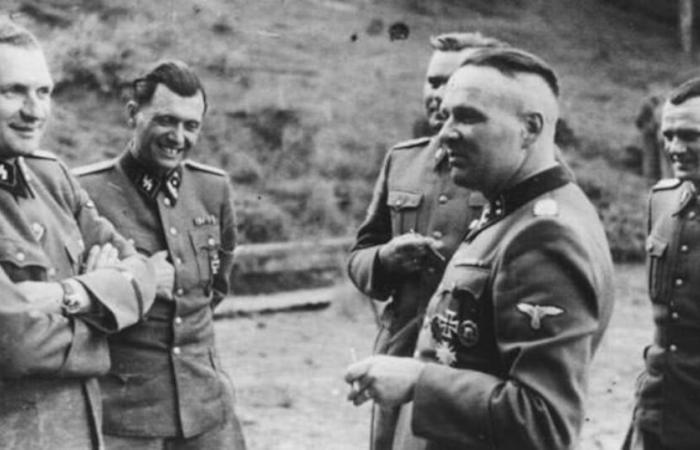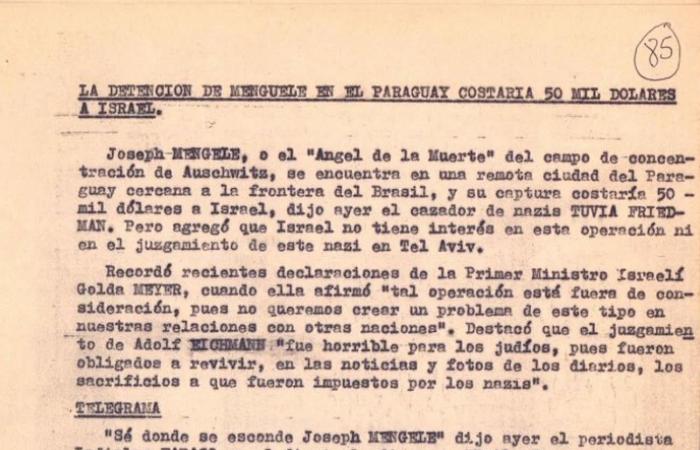The general Archive of the Nation (AGN), dependent on the interior cabinet vicepatura, made available on Monday of all citizens a series of declassified documents that include information about Nazis operations in Argentina, as well as secret and reserved presidential decrees, now available to the general public.
After a restoration, digitalization and description work, the agency published on its website all the declassified documentation housed in its documentary collection.
Nazi activities files in our country consist of around 1,850 documentary pieces, Corpus that the Argentine state delivered in copies to the Simón Wiecenthal center, which is currently investigating the links of the Credit Suisse Bank Suisse Nazism.
The delivery of the documentation was requested after a meeting that the authorities of the Center held with President Javier Milei at Casa Rosada, in February of this year.
Josef Mengele and Argentina
One of the strongest revelations includes Josef Mengelethe so -called “Angel of death” of Auschwitz, who managed to escape from Europe after the Nazi defeat in 1945.
According to the archives, its passage through Latin America, and especially in Argentina, was wrapped in protection networks, state indifference and ideological complicities.
From declassified documentation of Argentine intelligence services (Decree 232/1992), it is possible to rebuild their movements, support and concealment strategies.
Mengele, the archives say, entered Argentina on June 22, 1949.
Used a false passport in the name of Helmut Gregoridentity built to avoid International persecution for war crimes.
The document that facilitated its entrance was issued by the International Red Cross Committee, which at that time, often negligent or deliberately, extended papers to Nazis, fugitive.
Initially, he stayed in a central hotel in Buenos Aires and then in private homes.
The arrival occurred in a favorable context: the government of Juan Domingo Perón He maintained a permissive policy – and sometimes promoter – of the entry of scientists, military and Nazi officials, under the premise of taking advantage of their knowledge and strengthening strategic alliances.
Life in Buenos Aires
Once installed in Buenos Aires, Mengele moved with some freedom within the German community. Intelligence investigations show that he first resided in central areas of Federal Capital and later in peripheral neighborhoods, such as Vicente López and other localities of Buenos Aires.
He worked professionally in Fadro Farma pharmaceutical company linked to Germans based in Argentina. There he worked as a technical advisor, taking advantage of his knowledge in medicine, genetics and pharmacology, acquired criminally in Auschwitz.
His routine was characterized by a low profile. He avoided great social concentrations and only met with compound circles, mostly, by Nazi veteran or supporters.
His passage through Córdoba
According to the documentation, he worked as agricultural machinery seller In several Argentine provinces, in addition to its link with Fadro Farm. Reports detail sales trips to Santa Fe, Entre Ríosy Córdobawhich allowed him to move and “disappear” for periods without raising suspicions.
Protection networks
The file reveals that Mengele had a solid protection network, woven by German compatriots, ultra-right political exiles and some members of the German-Argentine community that sympathized with the Hitlerist regime.
Regular contacts are documented with Adolf Eichmannwho also resided in Buenos Aires under a false identity (Ricardo Klement). They shared not only friends, but also links with support networks that provided them with refuge, false documents and financing.
These networks included:
- Help associations to German immigrants.
- German educational and religious institutions.
- Small companies owned by Nazi expatriates.
The SIDE (State Intelligence Service) knew at least part of these connections, but, according to the documents, did not take actions to dismantle them.
-The attitude of the Argentine State
The documentation shows that Argentine agencies were aware of Mengele’s presence in the country since at least 1953.
However, a combination of negligence, cover -up and lack of political interest prevailed in capturing or extraditing it. The reports account for international capture orders, especially from Western Germany and Israel, but were systematically ignored or delayed.
In several reports of the reports it is suggested that Mengele and other Nazis were considered “harmless” by the Argentine authorities of that time, due to the passage of time from the war and its low profile.
The change of residence
The situation changed drastically in 1960, after the successful operation of the Israeli Mossad that kidnapped Adolf Eichmann In Buenos Aires and took him to Israel to be judged.
According to the information, he escaped by land.
That blow showed the vulnerability of Nazi fugitives in Argentina. Alerted, Mengele decided to flee immediately.
First he moved to Paraguay, where he obtained protection of the dictatorial regime of Alfredo Stroessner. There he moved under new identities, thanks to Paraguayan documents obtained easily in those years.
Although there are data that claim that he could have drawn a document in the name of “José Mengele.”
According to reports, he lived in a rural stay (it is said that in Pedro Caballero), away from urban centers.
However, international pressure persisted. Therefore, in the mid -60s, Mengele moved again, this time towards Brazil.
Physical characteristics and modus operandi
The documentation carefully details Mengele’s physical description:
- Average height (around 1.72 meters).
- Thin complexion.
- Dark hair, with pronounced tickets.
- Clear eyes, blue color.
- A notorious scar on the chin, a consequence of a motorcycle accident in its youth.
In addition, it is described as:
- Extremely reserved and distrustful.
- Very intelligent and adaptive.
- Obsessed with your personal safety.
- Reluctant to establish stable relationships that could give it away.
These features allowed him to sustain concealment for decades.

Mengele’s death
The SIDE recorded cross reports that, towards the end of the 70s, realized that Mengele would have died in Brazil.
The most accepted version – confirmed years later – indicates that Mengele died drowned in 1979, on a beach in Bertioga, São Paulo. A stroke would have left him unconscious at sea, causing his death.
His remains were buried under the false name of Wolfgang Gerhard. For years, his death was subject to conspiracy theories and theories.
In 1985, after excavations and DNA studies, it was officially confirmed that the remains found in Brazil effectively belonged to Mengele.
International connections
The report also refers to:
- Paraguayan collaboration: Stroessner offered Mengele not only refuge, but guarantees against possible extraditions. This included Paraguayan official identity and documentation.
- Brazilian collaboration: Although more limited, there were Brazilian ultra -right sectors that also supported their concealment.
- The performance of Israeli and German services: The Mossad and Judicial Body of Federal Germany actively sought Mengele, but without achieving their capture in life.
Final considerations
Mengele managed to avoid human justice thanks to:
- An international Nazi protection network.
- Passivity – and in certain cases, complicity – of state authorities in Argentina, Paraguay and Brazil.
- Your intelligence to move and build new identities.
- The lack of international will to deploy similar operations to the one that allowed Eichmann to capture.
Thus, the declassified documents show that their passage through Argentina was not brief or accidental: it lasted more than a decade and had the support of local sectors.
Note made with the exploratory help of chatgpt.com Based on the declassified document file 7-3771, folder 2 y to the 7-3772 file, folder 1.







